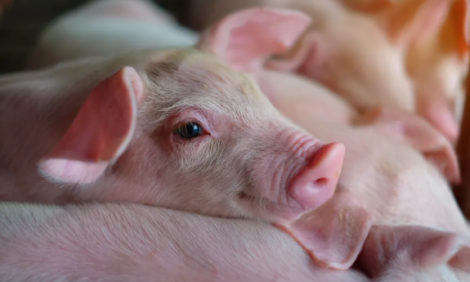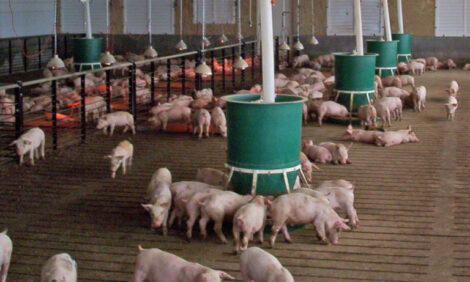



How Do the Danes Rear 35 Piglets Per Sow and Year?
One Danish pig farmer shared the secrets of his success in rearing more than 35 piglets per sow and year, saying it’s all about teamwork, attention to detail and the desire to be number 1. Jackie Linden reports.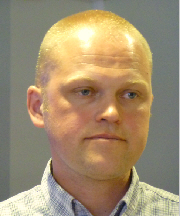
The Danes are renowned for their successful pig sector and appreciated worldwide for it and their quality pig meat.
From a farming family and with a background in agricultural economics and commerce, Tom Oestrup is a good example of a Danish pig farmer – one who has already broken through the barrier of 35 piglets weaned per sow per year.
Tom puts his success down to good teamwork and a determination to be number 1 but there is more to it than that.
He started farming with his father in 1998, with 270 sows and finishers at Bækgaarden, increasing the herd to 700 sows. In 2008, recurrent problems with enzootic pneumonia and issues over selling led Tom to take a big decision and depopulate the whole herd, and repopulate with high-health, high-performing gilts from Danavl.
Just 1.5km away is the second site at Eskebjerg, where Tom himself does the routine work and where there are 3,500 places for piglets between weaning (27 or 28 days of age and weighing 5kg) and almost 30kg, plus 700 grower-finisher places.
Last year, he sold 22,787 30-kg piglets. Mortality was 2.4 per cent and the daily growth rate was 460g. With permission to sell 4,000 slaughter pigs per year, Tom usually produces just 1,000 to 2,000.
Also at Eskbjerg is the quarantine facility for purchased gilts, which are brought in groups of 12 to 14 aged 26 to 28 weeks, three times a year.
Until 2007, Tom had bred his own gilts but then saw the performance advantages of modern genetics outweighed the possible risk of introducing disease.
“It’s all about protection against disease,” he said, explaining that having the second site lowers the chances of bringing in diseases The gilts he buys are of high health status, of course, and he also has insurance cover in case of health problems in the stock in quarantine.
Feed is grown and produced on the farm, with 190 hectares of feed wheat and barley, rapeseed and grass for seed. Using his own machinery and labour, he also farms 100 hectares for a neighbour, which together covers 90 per cent of the pigs’ total cereal requirement.

Pig Unit and Its Management
Farrowing house
Friday is the main farrowing day; sows are not induced but farrow naturally. Staff are on hand for up to 18 hours every day in the farrowing house.
In Tom’s opinion, it is more economical and better for welfare for sows to rear more than 14 piglets than to use nursing sows. Each week, there are no more than three nursing sows and they may have fewer than 10 piglets each. Nurse sows piglets are weaned at 21 days and the extra piglets at farrowing are put onto her.
Weaning is done when the piglets are 27 to 28 days of age generally and never before 21 days.
With the large litter sizes achieved, concern is sometimes expressed about lightweight pigs at weaning, which may not perform well for the rest of their lives.
At Bækgaarden, piglet food is offered from one week of age, explained Tom. Unlike some other Danish farms, they don’t use milk cups because of the risks of poor hygiene.
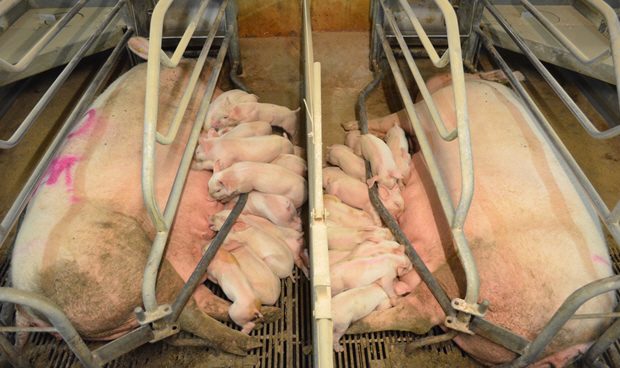
Sow management
Sows are kept in stalls for four weeks after weaning, in accordance with the EU regulations. A boar is used to stimulate the sows but all are artificially inseminated.
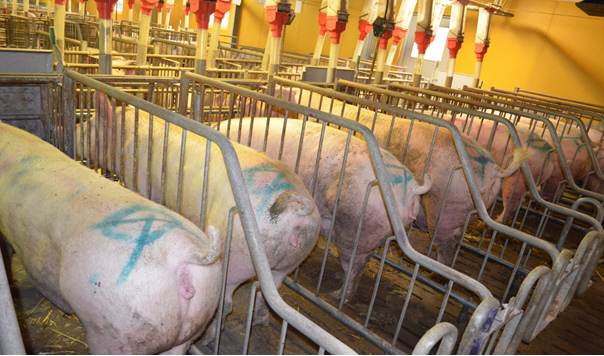
After the sows are confirmed in pig, they are transferred to the straw-bedded group house for the rest of pregnancy. There are up to 80 sows in each of the four pens; feeding is ad-lib.
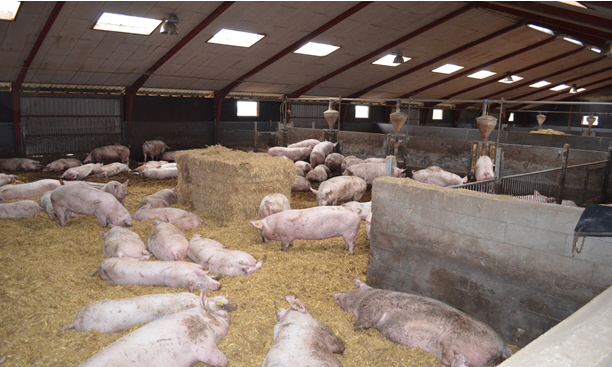
Nursery rooms
There is a nursery room for weaned piglets which benefit form a little extra care before being transferred to the other farm. There is space in the nursery for up to 45 of the smaller piglets weaned at 27 to 28 days and the same number of 21-day-old piglets from the nurse sows kept back in the farrowing room to rear the extra piglets from the current farrowing week.
The young pigs here are provided with a heat lamp and special, highly digestible feed.
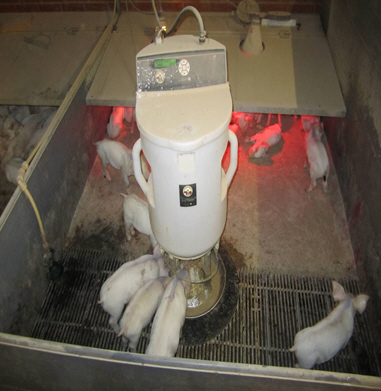
Weaner houses
Most of the weaned pigs move to partially slatted pens with automatic liquid feeding. Water is also provided separately.
Climate control in these houses is achieved through an unusual system of combined floor and ceiling fans, which keeps the pigs comfortable in summer and winter. Relative humidity control is important, according to Tom; he aims to keep it below 65 per cent.
For their first 10 to 15 days, the young pigs have underfloor heating and are provided with paper and other materials to occupy them.
Two feeds are made on farm for the young pigs. For the first 12 to 14 days, they get a feed containing 61 per cent wheat and a special protein concentrate, and this is followed by one that also includes barley and soybean meal.
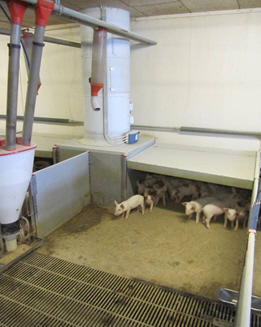
Key to Success: Employees and Their Motivation
Tom identified dedicated and motivated employees as top of his list to achieve top results.
In addition to his own time, Tom employs two managers from Ukraine, one for the farrowing house and one for the breeding house, plus two trainees from the same country and a Danish trainee for the arable and feed side.
Recruited through a Danish agency, the managers were already qualified as veterinary assistants but Tom has trained them ‘on the job’. He is clearly very pleased with their working practices and performance.
Motivating employees is an area Tom finds very important. They all meet for half an hour every morning to discuss regular work matters and weekly to follow up on current targets and set new ones. All the team are encouraged to feel responsible for and own good results.
Tom stressed the importance of setting realistic targets, for the full year and shorter periods. With 35 piglets per sow and year achieved in 2013, this year’s target was set at 35.5, for example. That target had already been reached mid-way through the year!
Rare cases of conflict need to be managed immediately, he said, and it’s important for him to show he is pleased when targets are reached as well as to demonstrate disapproval when things go wrong, as they occasionally do, even on the best farms.
The team is selective over, for example, new product testing because there needs to be proper follow-through for all projects started, and regular appraisal interviews help to avoid later larger issues.
Competition with other farms can be a good motivation, according to Tom. Certificates at the farm attest to a 2nd place in 2011, rising to 1st in 2012. Only coming 3rd last year was somewhat compensated by exceeding the farm’s own targets!
Tom is always looking to raise the farm’s scores for low production costs, particularly for feed and medicine use.
On medication, Tom explained that no routine medications are used. Individuals are treated, of course and painkillers are always given to sick animals.
If the pigs scour a little when the feed is switched, a few handfuls of potato flour seems to cure them.
Medication costs work out at most the equivalent of €100 over 35 days or just five Euro-cents per piglet sold.
Routines Followed – and Reviewed
Routines are important to achieve good results, Tom said. But these are not followed unthinkingly; he and his employees are always looking for ways to do things better.
Tom stressed the importance of high hygiene on the farm.
Passages are kept clear and clean all the time and are cleaned with soap and disinfectant after each shift. When moving around the unit, the staff always go from the smaller piglets to the large ones.
All items of equipment are properly cleaned and disinfected after every use.
Once the weaner accommodation is empty, it is well soaked for two days. It is then washed with detergent and disinfected and allowed to dry for three full days. The rooms are heated to 25°C the day before the newly weaned pigs are brought in. The water system is cleaned and sanitised between each batch.
Attention to Detail
Due diligence is followed with everything we're doing, said Tom.
For example, there is cover in the farrowing house for much of the day. Day time working hours are 07:00 to 16:00 and someone is on duty from 20:00 to 01:00, every single night. With 700 sows, 24-hour supervision is not practised on the farm.
Throughout the farm, records are kept on paper – where necessary in plastic bags for protection - rather than electronically. The systems are simple but easy for everyone to follow. The information from these cards is entered into the Agrosoft database, and that from the basis for discussion in the weekly management meetings, when attention is focused mainly on the 16-week figures, which more accurately show the performance trends.
Attention to detail over the feed goes as far as checking the particle size using sieves. Piglet feed is milled to between 1.5 and 2.5mm.
November 2014







